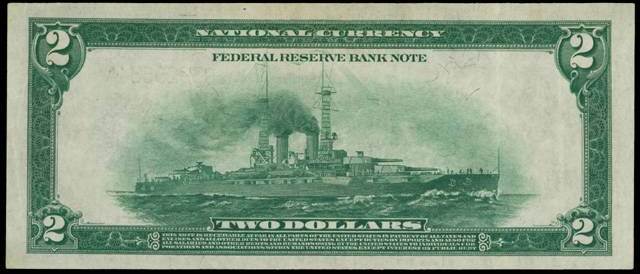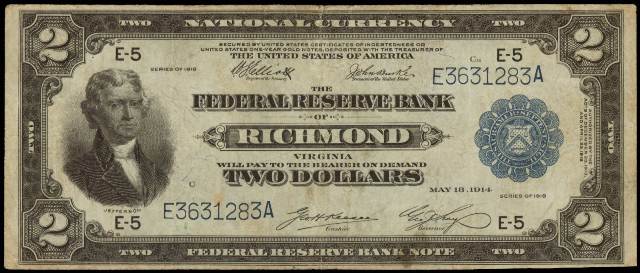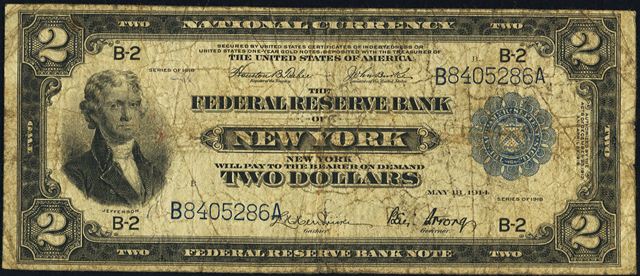Series of 1918 $2 Federal Reserve Note – Battleship Note
History: 1918 is the last year that large size two dollar bills were issued by the United States. 1918 was an interesting year for US currency. Lots of different types of notes were being issued including legal tenders, gold certificates, silver certificates, federal reserve notes, and federal reserve bank notes. Denominations between $1 and $10,000 were issued for 1918. The $2 bill from 1918 is very popular. It was issued by all twelve federal reserve banks. Some issues are quite scarce and others are frequently available. The rest of this article will tell you everything you want to know about values and pricing.
Nickname: It would take a long time to say “series of 1918 two dollar federal reserve bank note.” 99% of collectors simply call this note a battleship. The back of all 1918 $2 bills has an image of battleship. I don’t think the exact ship has ever been identified. As you can imagine, the battleship appeals to pretty much every collector or anyone who has ties to the United States Navy.
Other Facts: All 1918 federal reserve bank notes were issued with a blue seal. Most people associate blue seals with silver certificates; however, that is not the case here. People also assume that all two dollar bills are rare. Once again, that is not the case with series of 1918 $2 bills. As a type design they are actually quite common. There is certainly some rarity based on serial number and signature combination. It is safe to say that the “battleship” is on the top ten list of the most iconic United States paper money designs. Whether you have been collecting for one month or 50 years, you probably know exactly what the battleship note is. You will also notice that Thomas Jefferson was on the 1918 $2 bill. He was first pictured on that denomination in 1869 and he is still on two dollar bills today.
Values and Grading: We often talk about low serial numbers and how they affect values. Well this is a case where low serial numbers will not influence value by very much. There are hundreds of 1918 $2 bills with serial numbers under 1000, and dozens with serial numbers under 100. And as you might expect, all of those low serial number notes are almost always in choice uncirculated condition. That means that for as little as $2,000 you can buy a low serial number high grade battleship. That kind of skews other values. Some collectors still focus on signature combinations. We would strongly advise you to show us pictures of whatever you have so that we can check it for varieties.
Choice Uncirculated or Better: As we stated above, there are hundreds of uncirculated 1918 $2 bills out there. Back in the 1910s it was not difficult to save a $2 bill just because you liked it. Lots of them were saved. Most choice uncirculated 1918 two dollar bills should cost a little more than $2,000. Some signature combinations (fr. numbers) are exceedingly rare in high grades. The rarest signature combinations in a grade of 64 or higher might cost mid-four figures. Once again, if you send pictures then we can tell you if you have a rare signature combination.

Here Is A Low Serial Number UNC $2 Battleship
Extremely Fine to About Uncirculated: There is not an abundance of nice XF and AU battleship notes available on the market today. In recent years these have also languished in the market because of the plethora of high grade examples that were available for not a whole lot more money. A really nice looking XF 1918 $2 bill probably shouldn’t cost much more than $800. You can upgrade to an AU example for an extra $400. There is typically a wider range between 40 and 58, but not with 1918 $2 battleships.

This Exact $2 Battleship Should Sell For Around $800
Fine to Very Fine: It is very easy to locate 1918 $2 bills in fine condition. Fine condition implies a grade of 12 or 15 out of 70. Very fine battleships are a little bit tougher to find. A battleship in fine condition will be slightly dirty and it will have obviously spent some time in circulation. It should still be fully intact. A battleship in very fine condition can be a 20, 25, 30, or 35 out of 70. There is a big eye appeal difference between something graded as very fine 20 and VF 35. A 35 will have very few folds, crisp paper, and a bright overprint. Sometimes a Very Fine 20 doesn’t look much different than a fine 15. It will be slightly toned with softer paper. Prices range from about $350 to $800.

This Particular 1918 $2 Bill Graded As Fine 15
Very Good and Lower: We typically don’t recommend buying 1918 $2 battleships in low grades like VG and worse. A battleship in VG condition will be very heavily circulated. It could have lots of pinholes, rough margins, stains, damage, writing, or other issues that will just generally make it unappealing. Notes in this condition are usually worth less than $300. There is still value just for the curiosity factor alone. However, for not much more money you can buy a really attractive example.

A Low Grade $2 Battleship Like This Sells For Around $250
Need an Appraisal or Offer? We handle lots of 1918 $2 battleship notes. If you are looking to sell then send us pictures of what you have via email. We would be happy to share our opinion on value and make our best offer. We look forward to working with you. Sales@AntiqueMoney.com


